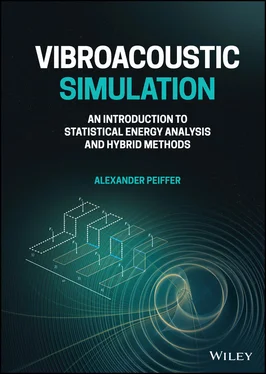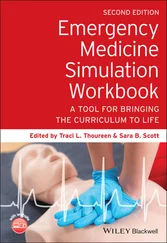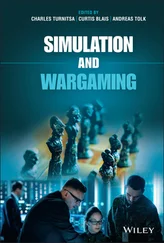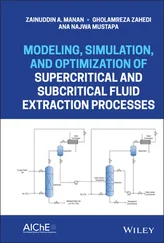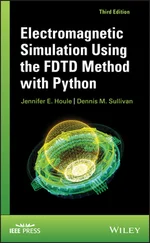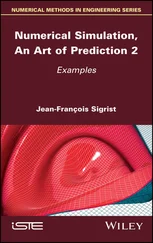Alexander Peiffer - Vibroacoustic Simulation
Здесь есть возможность читать онлайн «Alexander Peiffer - Vibroacoustic Simulation» — ознакомительный отрывок электронной книги совершенно бесплатно, а после прочтения отрывка купить полную версию. В некоторых случаях можно слушать аудио, скачать через торрент в формате fb2 и присутствует краткое содержание. Жанр: unrecognised, на английском языке. Описание произведения, (предисловие) а так же отзывы посетителей доступны на портале библиотеки ЛибКат.
- Название:Vibroacoustic Simulation
- Автор:
- Жанр:
- Год:неизвестен
- ISBN:нет данных
- Рейтинг книги:3 / 5. Голосов: 1
-
Избранное:Добавить в избранное
- Отзывы:
-
Ваша оценка:
- 60
- 1
- 2
- 3
- 4
- 5
Vibroacoustic Simulation: краткое содержание, описание и аннотация
Предлагаем к чтению аннотацию, описание, краткое содержание или предисловие (зависит от того, что написал сам автор книги «Vibroacoustic Simulation»). Если вы не нашли необходимую информацию о книге — напишите в комментариях, мы постараемся отыскать её.
Learn to master the full range of vibroacoustic simulation using both SEA and hybrid FEM/SEA methods Vibroacoustic Simulation
Vibroacoustic Simulation
Vibroacoustic Simulation
Vibroacoustic Simulation — читать онлайн ознакомительный отрывок
Ниже представлен текст книги, разбитый по страницам. Система сохранения места последней прочитанной страницы, позволяет с удобством читать онлайн бесплатно книгу «Vibroacoustic Simulation», без необходимости каждый раз заново искать на чём Вы остановились. Поставьте закладку, и сможете в любой момент перейти на страницу, на которой закончили чтение.
Интервал:
Закладка:
Vibroacoustic Simulation
An Introduction to Statistical Energy Analysis and Hybrid Methods
Alexander Peiffer

This edition first published 2022
© 2022 by John Wiley & Sons, Inc.
All rights reserved. No part of this publication may be reproduced, stored in a retrieval system, or transmitted, in any form or by any means, electronic, mechanical, photocopying, recording or otherwise, except as permitted by law. Advice on how to obtain permission to reuse material from this title is available at http://www.wiley.com/go/permissions.
The right of Alexander Peiffer to be identified as the author of this work has been asserted in accordance with law.
Registered Office
John Wiley & Sons, Inc., 111 River Street, Hoboken, NJ 07030, USA
Editorial Office
111 River Street, Hoboken, NJ 07030, USA
For details of our global editorial offices, customer services, and more information about Wiley products visit us at www.wiley.com.
Wiley also publishes its books in a variety of electronic formats and by print-on-demand. Some content that appears in standard print versions of this book may not be available in other formats.
Limit of Liability/Disclaimer of Warranty
The contents of this work are intended to further general scientific research, understanding, and discussion only and are not intended and should not be relied upon as recommending or promoting scientific method, diagnosis, or treatment by physicians for any particular patient. In view of ongoing research, equipment modifications, changes in governmental regulations, and the constant flow of information relating to the use of medicines, equipment, and devices, the reader is urged to review and evaluate the information provided in the package insert or instructions for each medicine, equipment, or device for, among other things, any changes in the instructions or indication of usage and for added warnings and precautions. While the publisher and authors have used their best efforts in preparing this work, they make no representations or warranties with respect to the accuracy or completeness of the contents of this work and specifically disclaim all warranties, including without limitation any implied warranties of merchantability or fitness for a particular purpose. No warranty may be created or extended by sales representatives, written sales materials or promotional statements for this work. The fact that an organization, website, or product is referred to in this work as a citation and/or potential source of further information does not mean that the publisher and authors endorse the information or services the organization, website, or product may provide or recommendations it may make. This work is sold with the understanding that the publisher is not engaged in rendering professional services. The advice and strategies contained herein may not be suitable for your situation. You should consult with a specialist where appropriate. Further, readers should be aware that websites listed in this work may have changed or disappeared between when this work was written and when it is read. Neither the publisher nor authors shall be liable for any loss of profit or any other commercial damages, including but not limited to special, incidental, consequential, or other damages.
A catalogue record for this book is available from the Library of Congress
Hardback ISBN: 9781119849841; ePub ISBN: 9781119849865; ePDF ISBN: 9781119849858; Obook ISBN: 9781119849872
Cover image: © visibleimpression/Shutterstock; Courtesy of Alexander Peiffer
Cover design by Wiley
Set in 10/12.5pt STIXTwoText by Integra Software Services Pvt. Ltd, Pondicherry, India
To my parents and Ivonnne my love who always supported me
Contents
1 Cover
2 Title page Vibroacoustic Simulation An Introduction to Statistical Energy Analysis and Hybrid Methods Alexander Peiffer
3 Copyright
4 Dedication
5 Preface
6 Acknowledgments
7 Acronyms
8 1 Linear Systems, Random Process and Signals 1.1 The Damped Harmonic Oscillator1.1.1 Homogeneous Solutions1.1.2 The Overdamped Oscillator (ζ < 1)1.1.3 The Underdamped Oscillator (ζ < 1)1.1.4 The Critically Damped Oscillator (ζ = 1)1.2 Forced Harmonic Oscillator1.2.1 Frequency Response1.2.2 Energy, Power and Impedance1.2.3 Impedance and Response Functions1.2.4 Damping1.2.5 Damping in Real Systems1.3 Two Degrees of Freedom Systems (2DOF)1.3.1 Natural Frequencies of the 2DOF System1.4 Multiple Degrees of Freedom Systems MDOF1.4.1 Assembling the Mass Matrix1.4.2 Assembling the Stiffness Matrix1.4.3 Power Input into MDOF Systems1.4.4 Normal Modes1.5 Random Process1.5.1 Probability Function1.5.2 Correlation Coefficient1.5.3 Correlation Functions for Random Time Signals1.5.4 Fourier Analysis of Random Signals1.5.5 Estimation of Power and Cross Spectra1.6 Systems1.6.1 SISO-System Response in Frequency Domain1.6.2 System Response in Time Domain1.6.3 Systems Excited by Random Signals1.7 Multiple-input.multiple-output Systems1.7.1 Multiple Random Inputs1.7.2 Response of MIMO Systems to Random LoadBibliography
9 2 Waves in Fluids 2.1 Introduction2.2 Wave Equation for Fluids2.2.1 Conservation of Mass2.2.2 Newtons law – Conservation of Momentum2.2.3 Equation of State2.2.4 Linearized Equations2.2.5 AcousticWave Equation2.3 Solutions of theWave Equation2.3.1 HarmonicWaves2.3.2 Helmholtz equation2.3.3 Field Quantities: Sound Intensity, Energy Density and Sound Power2.3.4 Damping inWaves2.4 Fundamental Acoustic Sources2.4.1 Monopoles Spherical Sources2.5 Reflection of PlaneWaves2.6 Reflection and Transmission of PlaneWaves2.7 InhomogeneousWave Equation2.7.1 Acoustic Greens Functions2.7.2 Rayleigh integral2.7.3 Piston in a Wall2.7.4 Power Radiation2.8 Units, Measures, and levelsBibliography
10 3 Wave Propagation in Structures 3.1 Introduction3.2 Basic Equations and Definitions3.2.1 Mechanical Strain3.2.2 Mechanical Stress3.2.3 Material Laws3.3 Wave Equation3.3.1 The One-dimensionalWave Equation3.3.2 The Three-dimensionalWave Equation3.4 Waves in Infinite Solids3.4.1 LongitudinalWaves3.4.2 Shear waves3.5 Beams3.5.1 LongitudinalWaves3.5.2 Power, Energy, and Impedance3.5.3 BendingWaves3.5.4 Power, Energy, and Impedance3.6 Membranes3.7 Plates3.7.1 Strain–displacement Relations3.7.2 In-planeWave Equation3.7.3 LongitudinalWaves3.7.4 ShearWaves3.7.5 Combination of Longitudinal and ShearWaves3.7.6 BendingWave Equation3.8 Propagation of Energy in DispersiveWaves3.9 FindingsBibliography
11 4 Fluid Systems 4.1 One-dimensional Systems4.1.1 System Response4.1.2 Power Input4.1.3 Pressure Field4.1.4 Modes4.2 Three-dimensional Systems4.2.1 Modes4.2.2 Modal Frequency Response4.2.3 System Responses4.3 Numerical Solutions4.3.1 Acoustic Finite Element Methods4.3.2 Deterministic Acoustic Elements4.4 ReciprocityBibliography
12 5 Structure Systems 5.1 Introduction5.2 One-dimensional Systems5.2.1 LongitudinalWaves in Finite Beams5.2.2 Bending wave in Finite Beams5.3 Two-dimensional Systems5.3.1 BendingWaves in Flat Plates5.4 Reciprocity5.5 Numerical Solutions5.5.1 Normal Modes in Discrete FormBibliography
13 6 Random Description of Systems 6.1 DiffuseWave Field6.1.1 Wave-Energy Relationships6.1.2 Diffuse Field Parameter of One-Dimensional Systems6.1.3 Diffuse Field Parameter of Two-Dimensional Systems6.1.4 Diffuse Field Parameter of Three-Dimensional Systems6.1.5 Topology Conclusions6.1.6 Auto Correlation and Boundary Effects6.1.7 Sources in the Diffuse Acoustic Field the Direct Field6.1.8 Some Comments on the Diffuse Field Approach6.2 Ensemble Averaging of Deterministic Systems6.3 One-Dimensional Systems6.3.1 Fluid Tubes6.4 Two-Dimensional Systems6.4.1 Plates6.4.2 Monte Carlo Simulation6.5 Three-Dimensional Systems–Cavities6.5.1 Energy and Intensity6.5.2 Power Input to the Reverberant Field6.5.3 Dissipation6.5.4 Power Balance6.5.5 Monte Carlo Simulation6.6 Surface Load of Diffuse Acoustic Fields6.7 ModeWave Duality6.7.1 Diffuse Field Energy6.7.2 Free Field Power Input6.8 SEA System Description6.8.1 Power Balance in Diffuse Fields6.8.2 Reciprocity Relationships6.8.3 Fluid Analogy6.8.4 Power Input6.8.5 Engineering Units6.8.6 MultipleWave FieldsBibliography
Читать дальшеИнтервал:
Закладка:
Похожие книги на «Vibroacoustic Simulation»
Представляем Вашему вниманию похожие книги на «Vibroacoustic Simulation» списком для выбора. Мы отобрали схожую по названию и смыслу литературу в надежде предоставить читателям больше вариантов отыскать новые, интересные, ещё непрочитанные произведения.
Обсуждение, отзывы о книге «Vibroacoustic Simulation» и просто собственные мнения читателей. Оставьте ваши комментарии, напишите, что Вы думаете о произведении, его смысле или главных героях. Укажите что конкретно понравилось, а что нет, и почему Вы так считаете.
